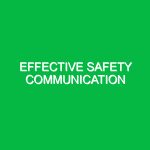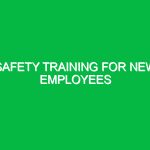In the ever-evolving landscape of Health, Safety, and Environment (HSE), organizations face a myriad of challenges. As industries grow and innovate, so too do the risks associated with them. This is where Advanced Risk Management Techniques come into play. These methodologies not only help in identifying potential hazards but also in developing effective strategies to mitigate them. In this article, we will explore these advanced techniques, their relevance in HSE, and how organizations can implement them to ensure a safer working environment.
Understanding Advanced Risk Management Techniques
Advanced Risk Management Techniques refer to sophisticated strategies and processes employed to identify, assess, and mitigate risks beyond traditional methods. They encompass a range of practices that utilize data analysis, predictive modeling, and systemic approaches to manage risks effectively. In the HSE domain, these techniques are crucial for safeguarding employees, protecting the environment, and ensuring compliance with regulations.
Using advanced techniques allows organizations to not only react to incidents but to anticipate and prevent them. This proactive stance can result in significant cost savings, improved employee morale, and a stronger reputation in the industry.
Identifying Potential Hazards and Risks
The first step in any risk management process is identifying potential hazards. In the HSE context, these hazards can be classified into several categories:
1. Physical Hazards
Physical hazards include environmental factors that can cause harm, such as noise, radiation, and extreme temperatures. For instance, in construction sites, heavy machinery poses a significant physical risk to workers. A compelling case is that of a major construction company that, through advanced risk assessment techniques, identified excessive noise levels as a risk factor leading to hearing loss among workers. They implemented noise monitoring systems and provided ear protection, ultimately reducing incidents of hearing-related injuries.
2. Chemical Hazards
Chemical hazards arise from exposure to harmful substances—be it through inhalation, skin contact, or ingestion. In an industrial setting, the improper handling of chemicals can lead to severe accidents. A notable example comes from the oil and gas sector, where companies utilize predictive analytics to foresee chemical leaks. By establishing a detailed inventory of chemicals and their properties, firms can implement better control measures to prevent spills and exposures.
3. Biological Hazards
Biological hazards involve exposure to harmful microorganisms, including bacteria, viruses, and fungi. In healthcare settings, for example, the risk of infection from bloodborne pathogens is significant. Advanced risk management techniques, such as the implementation of rigorous hygiene protocols and training programs, have proven effective in minimizing these risks. A study published in a medical journal highlighted how hospitals that adopted advanced sanitation methods saw a drastic reduction in infection rates.
4. Ergonomic Hazards
Ergonomic hazards are associated with workplace design and can lead to musculoskeletal disorders. In many cases, employees may suffer from chronic pain due to poor workstation setup. Companies that have adopted ergonomic assessments and redesigns have reported not only a reduction in injuries but also increased productivity. One company, after analyzing ergonomic risks in its assembly line, redesigned workstations and provided adjustable chairs, resulting in a noticeable drop in absenteeism due to back pain.
Safety Precautions and Best Practices
Once hazards are identified, organizations must implement safety precautions and best practices. Here are some actionable strategies:
1. Risk Assessment and Analysis
Conducting thorough risk assessments is foundational to effective risk management. This involves not only identifying hazards but also evaluating the likelihood and potential impact of these risks. Techniques such as Fault Tree Analysis (FTA) and Failure Mode and Effects Analysis (FMEA) can provide insights into potential failures and their consequences. By systematically analyzing risks, organizations can prioritize their mitigation efforts.
2. Training and Awareness Programs
Education is a critical component of risk management. Regular training sessions equip employees with the knowledge they need to recognize hazards and respond appropriately. For instance, a manufacturing company that instituted a continuous training program on chemical safety observed a marked decrease in accidents involving chemical spills. Employees became more vigilant and skilled in handling hazardous materials safely.
3. Implementation of Safety Technologies
Modern technologies can significantly enhance safety measures. For example, wearable technology, such as smart helmets and sensors, can monitor workers’ exposure to harmful conditions in real-time. An oil rig operator that adopted wearable tech reported a significant improvement in their incident response time, allowing for immediate intervention when hazardous conditions were detected.
4. Emergency Response Plans
No matter how robust your risk management techniques are, emergencies can still occur. Therefore, having a well-defined emergency response plan is essential. This plan should include procedures for evacuation, communication, and medical response. Regular drills ensure that employees know what to do in case of an incident, which can save lives. An example can be drawn from a chemical plant that faced a potential explosion; their extensive emergency preparedness drills allowed them to mitigate damage significantly when an incident occurred.
Regulations and Standards Governing Risk Management in HSE
Adhering to regulations and standards is paramount for effective risk management in HSE. Various frameworks guide organizations in implementing advanced risk management techniques:
1. Occupational Safety and Health Administration (OSHA)
OSHA sets and enforces standards to ensure safe and healthful working conditions. It provides guidelines for risk assessments and encourages the implementation of safety programs. Compliance with OSHA regulations is not just a legal requirement but a best practice in risk management.
2. ISO 45001
ISO 45001 is an international standard for occupational health and safety management systems. It provides a framework for organizations to proactively improve their safety performance. By adhering to ISO 45001, businesses can demonstrate their commitment to risk management and continuous improvement.
3. Environmental Protection Agency (EPA)
The EPA regulates hazardous materials and pollutants, establishing standards that organizations must follow to minimize environmental risks. Compliance with EPA regulations helps companies to avoid penalties and promotes sustainable practices.
The Future of Advanced Risk Management Techniques in HSE
As technology continues to evolve, the future of risk management in HSE looks promising. The integration of artificial intelligence and machine learning in predictive analytics is set to revolutionize how organizations approach risk. These technologies can analyze vast amounts of data, identifying patterns and predicting future risks with unprecedented accuracy.
Moreover, the growing emphasis on sustainability and corporate social responsibility is shaping the way organizations perceive risk management. Companies are increasingly recognizing that a proactive stance on HSE can enhance their brand reputation and foster trust among stakeholders.
Conclusion
Advanced Risk Management Techniques are essential for navigating the complexities of health, safety, and environmental challenges. By identifying potential hazards, implementing robust safety measures, and adhering to regulations, organizations can create a safer workplace. The integration of technology and a culture of continuous improvement will further enhance these efforts. As we move forward, the commitment to advanced risk management not only protects employees and the environment but also drives organizational success.


